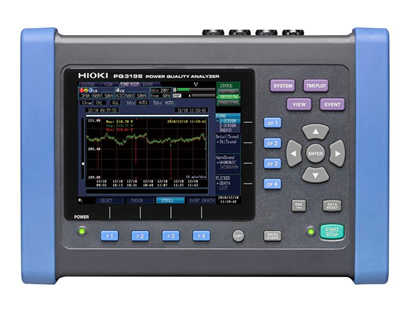HIOKI Launches Power Quality Analyzer PQ3198 |
Revamped Functionality and Specs Simplify Recording and Analysis of Power Supply Issues
PQ3198 Power Quality Analyzer
HIOKI is pleased to announce the launch of the Power Quality Analyzer PQ3198, a new instrument that revamps the functionality and specifications of its predecessor, the Power Quality Analyzer PW3198. The product makes it even easier to record and analyze power supply issues, including by eliminating the need for a dedicated sensor power supply and by enabling power and efficiency measurement of two circuits.
■ Development Background
As power circuits become more complex with increasing use of power electronics devices, large equipment, and geographically dispersed power supplies, power supply issues in the form of electronic device malfunctions and failures are becoming more common.
Drive AC flex sensor from PQ3198
HIOKI’s line of power quality analyzers currently consists of the mid-range PQ3100, launched in October 2016, and the flagship PW3198, launched in April 2011. Those instruments are paired with voltage cords and current sensors that measure voltage and current, respectively, and some of the latter require a separate, dedicated power supply. After HIOKI added functionality for powering current sensors to the PQ3100, there was increasing demand from customers to do the same for the flagship PW3198, which led HIOKI to redesign the model.
Solar power system
■ Principal New Functionality
1. Ability to supply power to sensors, eliminating the need for a dedicated power supply
The PQ3198 can supply power to AC flexible sensors*1 and AC/DC sensors*2, eliminating the need to provide a separate, dedicated power supply for those devices as they have required in the past. In addition to making it possible to use the instrument in outdoor locations where power is not readily available, this capability makes it easier to work in confined locations by reducing the number of wires needed to make measurements.
The PQ3198 can simultaneously measure power and efficiency on two circuits, for example in the primary (input) side and secondary (output) side of an EV rapid charger’s AC/DC converter or a solar power system.
The instrument can also measure DC to AC inverters with a fundamental frequency of 40 to 70 Hz and a carrier frequency*3 of 20 kHz or less.3. Remote measurement using FTP server functionality
The PQ3198 provides an FTP server function, making it easy to acquire data from the instrument remotely.4. Extended recording without the need to worry about the number of events (power anomalies)
Whereas the previous model (the PW3198) was able to record a maximum of 1000 events, the PQ3198 boosts that number to 9999. Further, it can record continuously for up to 366 days based on repeat recording settings.5. Standard support for analysis with PQ ONE analytical software
The PQ3198 ships with PQ ONE, a popular analytical software package that also comes with the Power Quality Analyzer PQ3100. Functionality includes display of event statistics (to display events by date or time of day), EN50160 judgment (for evaluation, analysis, and judgment capability that complies with the EN50160 standard), and report generation.
■ Principal Markets
Management of power quality and analysis of power supply issues by power companies, electricians, electrical maintenance engineers, building maintenance companies, electrical safety associations, and equipment end-users*1 AC flexible sensor: A loop-shaped AC sensor that can be bent freely. Used to measure wires with a large diameter and large currents. In the context of the PQ3198, “AC flexible sensors” refers to the AC Flexible Current Sensor CT7044/CT7045/CT7046.
*2: AC/DC sensor: A sensor that can measure either alternating or direct current. In the context of the PQ3198, “AC/DC sensors” refers to the AC/DC Auto Zero Current Sensor CT7731/CT7736/CT7742.
*3: Carrier frequency: The frequency that determines the timing at which the power semiconductors in an inverter circuit switch on and off.

